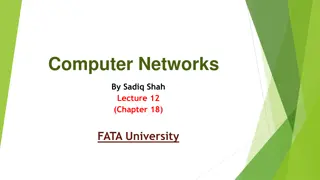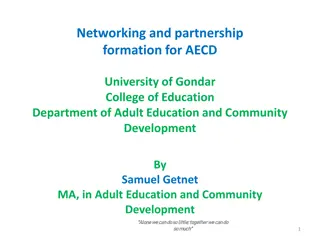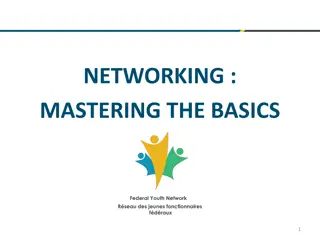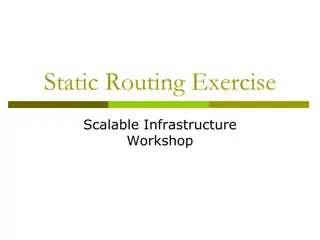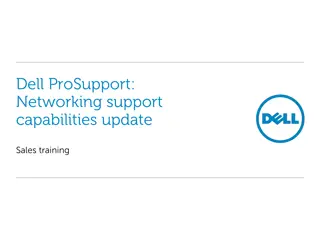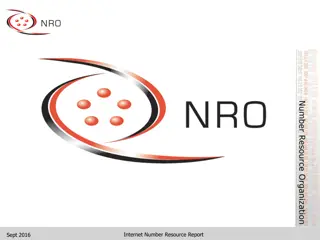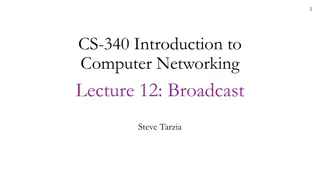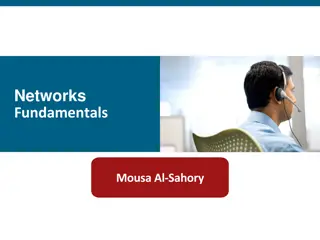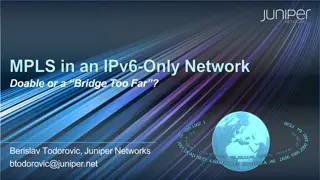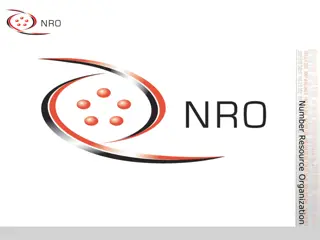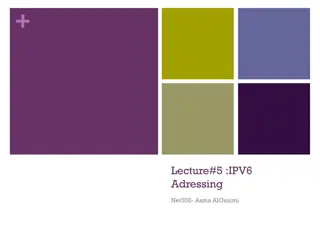IPv4 Networking Fundamentals
Explore crucial concepts in IPv4 networking, including addressing, protocol formats, network layer functions, datagram structure, header details, time-to-live considerations, and checksum verification. Delve into the intricacies of Internet Protocol version 4 to grasp the foundations of data communication and network operations in the digital realm.
Download Presentation

Please find below an Image/Link to download the presentation.
The content on the website is provided AS IS for your information and personal use only. It may not be sold, licensed, or shared on other websites without obtaining consent from the author. Download presentation by click this link. If you encounter any issues during the download, it is possible that the publisher has removed the file from their server.
E N D
Presentation Transcript
CIS454/554 Data Comm. Networks Lecture 11 Wenbing Zhao (Part of the slides are based on Drs. Kurose & Ross s slides for their Computer Networking book) 10/10/2024 1
Outline Internet protocol v4 IPv4 Addressing Classful IP address allocation CIDR Network address translation Internet Control Message Protocol 10/10/2024 Wenbing Zhao
The Network Layer in Internet Host, router network layer functions: Transport layer: TCP, UDP IP protocol Routing protocols path selection RIP, OSPF, BGP addressing conventions datagram format packet handling conventions Network layer forwarding table ICMP protocol error reporting router signaling Link layer physical layer 10/10/2024 3
IPv4 Datagram Format IP protocol version number header length (bytes) type of data 32 bits total datagram length (bytes) Total length fragment offset IHLtype of service ver for fragmentation/ reassembly flgs 16-bit identifier time to live 32 bit source IP address max number remaining hops (decremented at each router) header checksum protocol 32 bit destination IP address upper layer protocol to deliver payload to How much overhead with TCP? 20 bytes of TCP 20 bytes of IP = 40 bytes + app layer overhead E.g. timestamp, record route taken, specify list of routers to visit. Options (if any) data (variable length, typically a TCP or UDP segment) 10/10/2024 4
The IPv4 Header Version 4 IHL length of header in 32-bit words Min 5, max 15 i.e., 60 bytes Type of service - to distinguish different classes of service To accommodate differentiated services (which class this packet belongs to) Total length header and data 65,535 (216-1) bytes Identification allows destination to determine which datagram a fragment belongs to 10/10/2024 5
The IPv4 Header Time to live counter to limit packet lifetimes Max lifetime 255sec Packet is destroyed when counter becomes 0 Protocol which transport layer protocols being used Header checksum verifies header 10/10/2024 6
The IPv4 Header Options security, error reporting, etc. Some of the IP options 10/10/2024 7
IPv4 Addresses 10/10/2024 Wenbing Zhao
IPv4 Addresses IP address are usually written in dotted decimal notation Each of the 4 bytes is written in decimal, from 0 to 255 Lowest IP 0.0.0.0, highest 255.255.255.255 Special IP addresses 10/10/2024 Wenbing Zhao
Subnets Allow a network to be split into several parts for internal use, but to act as a single network to outside world Take some bits away from host numbers Subnet mask needed by the main router. Indicates split between network + subnet number and host Write the address and the mask as a binary number If mask bit is 1, then corresponding bit of address matters 10/10/2024 Wenbing Zhao
Subnets E.g., A class B network can be subnetted into 64 subnets Originally 16 bits for host info. Now, 6 bits used for subnet and 10 bits for host numbers Subnet mask can be written as 255.255.252.0 or /22 Subnet 1: 10000010 00110010 000001 00 00000001 130.50.4.1 Subnet 2: 10000010 00110010 000010 00 00000001 130.50.8.1 Subnet 3: 10000010 00110010 000011 00 00000001 130.50.12.1 A subnet is often represented in the form of base addr/mask: 130.50.4.0/22 10/10/2024 Wenbing Zhao
Problems with Classful Addressing A class is obviously too large for any organization C class is too small (only 256 addresses available) B class is requested and allocated, but it is still too large for most organizations Many IP addresses are wasted Shortage of IP addresses 10/10/2024 Wenbing Zhao
CIDR Classless InterDomain Routing For the remaining IP addresses, classless allocation is used Allocate remaining IP addresses in variable-sized blocks (must be power of 2), without regard to the classes The starting address must fall on the boundary of the block size E.g., if a site needs, say, 2000 addresses, it is given a block of 2048 addresses on a 2048-byte boundary 10/10/2024 Wenbing Zhao
Classless Allocation Example Routing tables are updated with the three assigned entries. Each entry contains a base address and a subnet mask (in short: base address/subnet mask) C: 11000010 00011000 00000000 00000000 11111111 11111111 11111000 00000000 E: 11000010 00011000 00001000 00000000 11111111 11111111 11111100 00000000 O: 11000010 00011000 00010000 00000000 11111111 11111111 11110000 00000000 Base address Subnet mask 10/10/2024 Wenbing Zhao
Classless Allocation Example For Cambridge: Ask 2000, allocate 211 = 2048 IP addresses block Start IP: 194.24.0.0 because it is multiple of 211 (-------- -------- 00000000 00000000) Last IP: 194.24.7.255 (i.e., 194.24.0.0 + 211 - 1: -------- -------- 00000111 11111111) Mask: 194.24.0.0/21 (8+8+5=21, or 32-11=21) For Edinburgh: Ask 1000, allocate 210 = 1024 IP addresses Start IP: 194.24.8.0 because it is multiple of 210 (-------- -------- 00001000 00000000) Last IP: 194.24.11.255 (i.e., 194.24.8.0 + 210 - 1: -------- -------- 00001011 11111111) Mask: 194.24.8.0/22 10/10/2024 Wenbing Zhao
Classless Allocation Example For Oxford: Ask 4000, allocate 212 = 4096 IP addresses Start IP: is 194.24.12.0 multiple of 4096? 194.24.12.0: -------- -------- 00001100 00000000 4096: -------- -------- 00010000 00000000 No. => We can t use 194.24.12.0 as the start IP for Oxford What is the next higher IP address that is multiple of 4096? 194.24.16.0: -------- -------- 00010000 00000000 => this is our start IP for O Last IP: 194.24.31.255: -------- -------- 00011111 11111111 Mask: 194.24.16.0/20 10/10/2024 Wenbing Zhao
Classless InterDomain Routing Each routing table is extended by giving it a 32-bit mask The routing table contains entries of (IP address, subnet mask, outgoing line) triples When a packet comes in, its destination IP address is first extracted Then, the routing table is scanned entry by entry, masking the destination address and comparing it to the table entry looking for a match If multiple entries (with different subnet mask lengths) match, the longest mask is used E.g., if there is a match for a /20 mask and a /24 mask, the /24 mask is used 10/10/2024 Wenbing Zhao
CIDR Routing: Example If a packet is addressed to 194.24.17.4, in binary 11000010 00011000 00010001 00000100 First it is Boolean ANDed with the Cambridge mask to get 11000010 00011000 00010000 00000000 This value does not match the Cambridge base address, so next try Edinburgh mask, to get 11000010 00011000 00010000 00000000 This value still does not match, so Oxford is tried, yielding 11000010 00011000 00010000 00000000 This value matches the Oxford base. If no longer matches are found, the Oxford entry is used and the packet is sent along the line named in it C: 11000010 00011000 00000000 00000000 11111111 11111111 11111000 00000000 E: 11000010 00011000 00001000 00000000 11111111 11111111 11111100 00000000 O: 11000010 00011000 00010000 00000000 11111111 11111111 11110000 00000000 Base address Subnet mask 10/10/2024 Wenbing Zhao
NAT Network Address Translation Another workaround for the IP addresses shortage problem: network address translation One public IP address, many private IP addresses When a packet exits the private network and goes to the ISP, an address translation takes place Three ranges of IP addresses have been declared as private: 10.0.0.0 10.255.255.255 (16,777,216 hosts) 172.16.0.0 172.31.255.255/12 (1,048,576 hosts) 192.168.0.0 192.168.255.255/16 (65,536 hosts) 10/10/2024 Wenbing Zhao
NAT Network Address Translation Placement and operation of a NAT box 10/10/2024 Wenbing Zhao
NAT What about the Incoming Traffic? Solution is based on the assumption all traffic is TCP/UDP TCP/UDP has two port fields, one for source port, the other for destination port, each 16 bits wide The source port is used as an index to an internal table maintained by the NAT box The internal sender s private IP and original port info are stored in the table When the reply comes back, it will carry the index as the destination port, the NAT box then translates the address back For both outgoing and incoming address translations, the TCP/UDP and IP header checksums are recomputed 10/10/2024 Wenbing Zhao
NAT in Action 137.142.142.71 Src: 192.168.8.4:1333 Src: 137.142.142.71:1 Dst: 137.142.140.2:80 Dst: 137.142.140.2:80 Src: 137.142.140.2:80 192.168.8.4:1333 192.168.8.4:1333 1 1 Dst: 137.142.142.71:1 Src: 137.142.140.2:80 Dst: 192.168.8.4:1333 Public Network Private Network 10/10/2024 Wenbing Zhao
Drawback of NAT NAT violates the architectural model of IP, which states that every IP address uniquely identifies a single machine worldwide NAT box must maintain mapping info for each connection passing through it. This changes the Internet from a connectionless network to a kind of connection-oriented network NAT violates the most fundamental rule of protocol layering: layer k may not make any assumptions about what layer k+1 has put into the payload field NAT only support UDP/TCP traffic NAT has problem supporting apps that include local IPs in payload, such as FTP and H.323 Each NAT box can support at most 65,536 (216) hosts 10/10/2024 Wenbing Zhao
Internet Control Message Protocol When something unexpected occurs in Internet, the event is reported by routers using ICMP Principal ICMP message types 10/10/2024 Wenbing Zhao
Internet Control Message Protocol ICMP messages are sent using the basic IP header The first byte of the data portion of the datagram is a ICMP type field The type field determines the format of the remaining data Typical format: type, code plus first 8 bytes of IP datagram that has caused the error 0 1 2 3 0 1 2 3 4 5 6 7 8 9 0 1 2 3 4 5 6 7 8 9 0 1 2 3 4 5 6 7 8 9 0 1 +-+-+-+-+-+-+-+-+-+-+-+-+-+-+-+-+-+-+-+-+-+-+-+-+-+-+-+-+-+-+-+-+ | Type | Code | Checksum | +-+-+-+-+-+-+-+-+-+-+-+-+-+-+-+-+-+-+-+-+-+-+-+-+-+-+-+-+-+-+-+-+ | unused | +-+-+-+-+-+-+-+-+-+-+-+-+-+-+-+-+-+-+-+-+-+-+-+-+-+-+-+-+-+-+-+-+ | Internet Header + 64 bits of Original Data Datagram | +-+-+-+-+-+-+-+-+-+-+-+-+-+-+-+-+-+-+-+-+-+-+-+-+-+-+-+-+-+-+-+-+ Destination Unreliable Message Format 10/10/2024 Wenbing Zhao
Homework#3.2 Objective 2: Able to compute the forwarding table using the distance vector routing method Important concepts/knowledge (please elaborate each) Computation objective Information exchanged between neighboring nodes Algorithm used to compute/update forwarding table Key points Never compute/update the cost/outgoing link for the entry corresponding to the router itself! Problem: Consider the subnet shown below. Distance vector routing is used, and the following vectors have just come in to router C: from B: (5, 0, 8, 12, 6, 2); from D: (16, 12, 6, 0, 9, 10); and from E: (7, 6, 3, 9, 0, 4). The measured delays to B, D, and E, are 6, 3, and 5, respectively. What is C's new routing table? Give both the outgoing line to use and the expected delay. Please show all intermediate steps! 10/10/2024 26
Homework#3.3 Objective 3: Understand the issues with the distance vector routing method Important concepts/knowledge (please elaborate each) The count-to-infinity issue The fundamental reason for the count-to-infinity issue 10/10/2024 27
Homework#3.4 Objective 4: Understand how the time-to-live field in the IPv4 header is used Important concepts/knowledge (please elaborate each) Size of the TTL field (hence, max and min value of the TTL value) How the TTL field is updated What happens when TTL drops to 0 Objective of the TTL field Key points TTL is never increased in an IPv4 packet Problem: (a) If TTL=9 when an IPv4 packet leaves a router, what is the TTL value when that packet entered the router? (b) If TTL=1 when an IPv4 packet arrives at a router, and this router is not the final destination of the packet, what would happen to this packet? (c) When an IPv4 packet leaves a router, what fields in the IPv4 header would be different from those when the packet entered the router and why? 10/10/2024 28
Homework#3.5 Objective 5: Understand the classful IPv4 addressing Important concepts/knowledge (please elaborate each) Definition of class A, class B, and class C IPv4 dotted decimal notation Special IPv4 addresses IPv4 subnetting: why and how it is accomplished Issues with classful addressing Problem: Given a class B network, if the administrator wanted to subnet it to 32 subnets, answer the following questions: (a) How many bits will be taken from the host bits to designate each subnet? (b) Please denote the subnet mask in both the dotted decimal format and /xx formats. (c) How many hosts are there in each subnet (including special IPv4 addresses). (d) How many subnets can be created in the class B network? 10/10/2024 29
Homework#3.6 Objective 6: Understand Classless InterDomain Routing (CIDR) Important concepts/knowledge (please elaborate each) Rules for CIDR address allocation regarding the size of the block and the beginning of the address What it means by an address falls on the boundary of the block size , and how to determine it? Notation for a CIDR network in w.x.y.z/s format How to calculate quickly the CIDR subnet mask Problem: According to Classless InterDomain Routing, the remaining IP addresses are allocated in variable-sized blocks, without regard to the classes. However, the starting address must fall on the boundary of the block size allocated. Assuming that a large number of consecutive IP address are available starting at 194.24.0.0. Suppose that three organizations, A, B, and C, request 4000, 1000, and 2000 addresses, respectively, and in that order. For each of these, give the first IP address assigned, the last IP address assigned, both must be in dotted decimal form, and the mask in the w.x.y.z/s notation. 10/10/2024 30
Homework#3.7 Objective 7: Understand IPv4 Network Address Translation (NAT) Important concepts/knowledge (please elaborate each) Ranges of private IPv4 addresses Key ideas behind NAT (what the NAT box would have to do) Limitations of NAT Problem: Answer the following questions regarding NAT. (a) What is the maximum number of hosts can be accommodated by a single NAT box? (b) If an application-level protocol embed the sender s local IP in its playload, what would have to be done by the NAT box? 10/10/2024 31









